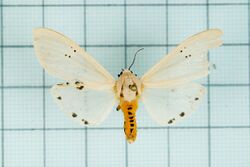Biology:Creatonotos transiens
| Creatonotos transiens | |
|---|---|

| |
| Creatonotos transiens vacillans | |
| Scientific classification | |
| Domain: | Eukaryota |
| Kingdom: | Animalia |
| Phylum: | Arthropoda |
| Class: | Insecta |
| Order: | Lepidoptera |
| Superfamily: | Noctuoidea |
| Family: | Erebidae |
| Subfamily: | Arctiinae |
| Genus: | Creatonotos |
| Species: | C. transiens
|
| Binomial name | |
| Creatonotos transiens (Walker, 1855)
| |
| Synonyms | |
| |
Creatonotos transiens is a moth of the family Erebidae. The species was first described in Western literature by Francis Walker in 1855.
Distribution
C. transiens is found in China (Shanxi, Shaanxi, central China, Tibet, Yunnan, Sichuan, Hong Kong, Hainan, Guizhou, Hubei, Hunan, Zhejiang, Fujian), Taiwan, Japan (Ryukyu), eastern Afghanistan, Pakistan , India , Bangladesh, Nepal, Bhutan, Myanmar, Indochina, Borneo, Bali and Lombok.[1] Records attributed to the Philippines are likely referable to Creatonotos wilemani Rothschild, 1933, as Dubalotov & Holloway[2] noted misplaced wilemani material in The Natural History Museum, London, collections. Records attributed to Sulawesi are referable to Creatonotos kishidai Dubalotov & Holloway, 2007
Subspecies
This list follows Holloway's interpretation from Moths of Borneo, part 6, as updated in Dubalotov & Holloway ([2006], 2007)
- Creatonotos transiens transiens (India, northern Pakistan)
- Creatonotos transiens albina (Daniel, 1971) (Afghanistan)
- Creatonotos transiens koni Miyaki, 1909 (Taiwan, Japan (Ryukyu Is.)) (revived from synonymy with vacillans by Dubalotov & Holloway ([2006], 2007))
- Creatonotos transiens vacillans (Walker, 1855) (=Creatonotos transiens orientalis Nakamura, 1976) (mainland China, Hong Kong, mainland South East Asia, Sumatra, Borneo))
- Creatonotos transiens sundana Nakamura, 1976 (Siberut, Java, Bali east to Lombok)
Ecology
Adults of C. transiens can be found in various secondary habitats.[3] Males of several Creatonotos species, including C. transiens possess inflatable coremata for dispersing pheromones prior to courtship of females; pheromone release and courtship take place within a couple of hours after sunset.[4]
The larvae feed on a wide range of plants, including Beta, Dioscorea, Paspalum, Zea, Pithecellobium, Vigna, Wisteria, Toona, Musa, Salix, Cayratia and Cissus species. The larvae are dark brown, with a very pale yellow dorsal stripe.[5]
References
- ↑ Savela, Markku. "Creatonotos transiens (Walker, 1855)". http://www.nic.funet.fi/pub/sci/bio/life/insecta/lepidoptera/ditrysia/noctuoidea/arctiidae/arctiinae/creatonotos/#transiens. Retrieved March 19, 2018.
- ↑ Dubatolov, V. & Holloway J., 2007: "A new species of the Creatonotos transiens-group (Lepidoptera: Arctiidae) from Sulawesi, Indonesia". Bonner zoologische Beiträge. 55 (2): 113-121.
- ↑ Černý, Karel (January 3, 2011). "A Review of the subfamily Arctiinae (Lepidoptera: Arctiidae) from the Philippines". Entomofauna 32 (3): 29–92. https://www.zobodat.at/pdf/ENT_0032_0029-0092.pdf.
- ↑ Wunderer, H., Hansen, K., Bell, T.W., Schneider, D & Meinwald, J., 1986: "Sex pheromones of two Asian moths (Creatonotos transiens, C. gangis; Lepidoptera--Arctiidae): behavior, morphology, chemistry and electrophysiology".Experimental Biology. 46 (1): 11-27.
- ↑ The Moths of Borneo
Wikidata ☰ Q5183601 entry
 |

